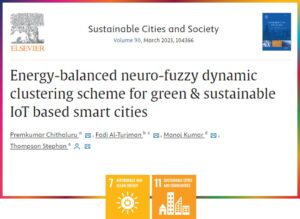
Researchers from Near East University’s AI and Robotics Institute have introduced an approach to address the challenges of resource management and sustainability in the Internet of Things (IoT), particularly in the context of smart cities aiming for sustainability. In a recent study, they proposed an innovative energy-efficient Dynamic Clustering Routing (DCR) protocol, integrating neuro-fuzzy techniques, to optimize the resource utilization of IoT devices, crucial for sustainable smart city applications.
The study acknowledges that sustainable IoT applications demand stringent requirements, including energy efficiency, Quality of Service (QoS), and efficient utilization of hardware and software resources. To confront these challenges, the researchers developed the DCR protocol, leveraging a dynamic self-organizing neural network to create adaptive clusters within IoT networks. Using TinyOS for test-bed analysis, the proposed protocol exhibited remarkable performance in real-time event detection and sensor node clustering.
The simulation results showcased the protocol’s superiority over established green communication routing protocols such as LEACH and LEACH-C. Notably, the proposed model demonstrated an average 35% gain across critical performance metrics like network lifetime, convergence time, packet delivery, and resource utilization.
Key to this innovation is the application of neuro-fuzzy logic for dynamic clustering and cluster head (CH) selection, enhancing resource management and network longevity. By harnessing artificial intelligence, the protocol dynamically organizes clusters based on sustainable IoT parameters, significantly optimizing network performance and resource utilization.
Moving forward, the research suggests further enhancements by exploring dynamic node selection strategies based on distance metrics to extend network lifetime, thereby cementing its commitment to advancing sustainable IoT-based smart city initiatives.
For further details, access the original paper from the publisher’s link:
https://www.sciencedirect.com/science/article/pii/S2210670722006710